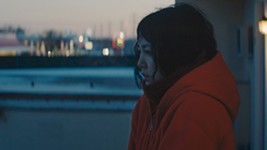Life and Death in Miniature in Marwencol
Director Jeff Malmberg on one trauma survivor's path back to life
By Ashley Moreno, Fri., March 19, 2010
Jeff Malmberg's SXSW Jury Award-winning documentary feature Marwencol focuses on Mark Hogancamp, who was attacked 10 years ago outside a bar. The severe injuries from the assault left him with amnesia. The little he recalls of his former life comes to him in the form of stills – like photographs.
To cope with his trauma, Hogancamp maintains a 1:6-scale, World War II-themed town called Marwencol. He has an alter ego, named Hogie, who owns a bar there; doll versions of his family and neighbors – and now filmmaker Malmberg and his wife – call the model city home. He photographs the dolls as they live out complex narratives.
"Within each of those stills, there is a story," says Malmberg. "It's not like [Hogancamp] is photographing these things and thinking, 'I'm going to shoot a really great shot of [G.I.] Joes by the waterfall refilling their canteens because it'll look really beautiful.' That shot of the Joes sitting by the waterfall filling up their canteens has a whole story behind it," Malmberg said. "He's living this with these people and documenting it himself."
Because so many dolls correspond to real people, their narratives can cause discomfort – perhaps as in true documentary. This happened with Colleen Vargo, Hogancamp's neighbor, and Ruthie Hotaling, a co-worker. A relationship develops between Vargo's and Hogancamp's alter egos that makes her uncomfortable, as she's married in real life. And a run-in with the SS removes Hotaling from the story altogether.

"It went down like this," Malmberg recalls. "Mark walks into the kitchen. Ruthie's in the kitchen. Mark says, 'Hey, Ruthie, how's it going?' Ruthie says, 'Good, what's my doll doing these days?' And Mark, who I think at this point was mad at Ruthie about something in real life, said: 'Oh, your doll got killed by the SS. Sorry.' And the look on her face was, like, crushed."
Malmberg's character reflects an interesting dynamic as well. "When my doll first came in, he was a German photographer," Malmberg says. "He wasn't in the SS, but he was German. Mark could tell I was a little curious why he made that decision. A couple weeks later he sent me some stills and said, 'Jeff, your doll switched sides!'" Overall, the inhabitants of Marwencol accept their uncertain roles. "If your doll meets a bad end," Malmberg says, "it was nice to be in the story."
Tod Lippy, the editor-in-chief of Esopus magazine, first learns of Marwencol when he sees Hogancamp walking a doll-filled Jeep. Lippy eventually helps Hogancamp land a show in a fashionable New York gallery. Surprisingly, this proves counter to Hogancamp's vision. "I thought, and I know Todd thought, maybe he'll get another show and that will lead to an artist's rep," Malmberg says. "It took us all a little while to realize that truly wasn't what he wanted out of this. It was his therapy. As much as that seems like an obvious thing, human nature wants, in a narrative sense, Mark to be better from this. ... In the years since the art show, he's probably retreated further into Marwencol."
Marwencol
Documentary Feature, Documentary Competition
Friday, March 19, 1:15pm, Ritz 2
Saturday, March 20, 5pm, Lamar 2
See www.marwencol.com for a gallery of Mark Hogancamp's Marwencol photography.













